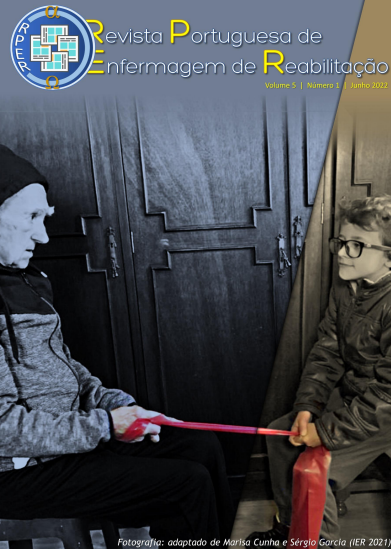Abstract
Objectives: Analyze whether the positioning is performed in an antispastic pattern in persons following a cerebrovascular accident (Stroke), which positions are most used and whether these decisions are influenced by the characteristics of patients or of the nurses.
Methodology: Quantitative and cross-sectional study carried out in a hospital located in Northern of Portugal. The sample consists of the pattern positioning performed by nurses in persons following cerebrovascular accident, admitted to a neurology ward service. The sampling technique is a non-probability and was selected by convenience. Data collection took place between February and May 2019 using a form and observation of positions in an antispastic pattern.
Results: Of the 376 positions, the most frequent was the supine (dorsal decubitus) position (n=152) and the least frequent the sitting position (n=28). The lateral decubitus position for the affected side obtained a higher average. The percentage of positioning with maximum classification, that is, with all body segments positioned in an antispastic pattern, was residual. Regarding the patients, the affected hemibody, spasticity and joint amplitude were significantly related to the classifications attributed to the positions. Regarding professional training, rehabilitation nurses positioned better in antispastic pattern in the supine position and in the lateral position to the unaffected side.
Conclusion: During hospitalization, nurses do not systematically position persons following a stroke, in an anti-spastic pattern and the gaps identified in the positioning of various body segments require (re)thinking practices.
References
Donkor ES. Stroke in the 21st Century: A Snapshot of the Burden, Epidemiology, and Quality of Life. Stroke Res Treat. 2018;1-10. DOI: https://doi.org/10.1155/2018/3238165.
Govender P, Naidoo D, Bricknell K, Ayob Z, Message H, Njoko S. No one prepared me to go home: Cerebrovascular accident survivors' experiences of community reintegration in a peri-urban context. Afr J Prim Health Care Fam Med. 2019;11(1):1-8. DOI: https://doi.org/10.4102/phcfm.v11i1.1806.
National Institutes of Health. Post-Stroke Rehabilitation [PDF]; 2020. Available from: https://www.stroke.nih.gov/documents/Post-Stroke_Rehabilitation_english_brochure_508C.pdf
Tamburri LM, Hollender KD, Orzano D. Protecting Patient Safety and Preventing Modifiable Complications After Acute Ischemic Stroke. Crit Care Nurse. 2020; 40(1):56-65. DOI: https://doi.org/10.4037/ccn2020859.
Teasell R, Hussein N, Iruthayarajah J, Saikaley M, Longval M, Viana R. Stroke Rehabilitation Clinical Handbook [PDF]; 2020. Available from: Clinician's Handbook EBRSR - Evidence-Based Review of Stroke Rehabilitation
Hardicre NK, Crocker TF, Wright A, Burton LJ, Ozer S, Atkinson R, et al. An intervention to support stroke survivors and their carers in the longer term (LoTS2Care): study protocol for the process evaluation of a cluster randomised controlled feasibility trial. Trials. 2018;19:1-12. DOI: https://doi.org/10.1186/s13063-018-2683-7.
International Council of Nureses [ICN] (2019). ICNP Browser: -Espasticidade. Available from: https://www.icn.ch/what-we-do/projects/ehealth/icnp-browser
Doussoulin A, Rivas C, Bacco J, Sepúlveda P, Carvallo G, Gajardo C, et al. Prevalence of Spasticity and Postural Patterns in the Upper Extremity Post Stroke. J Stroke Cerebrovasc Dis. 2020;29(11):105253. DOI: https://doi.org/10.1016/j.jstrokecerebrovasdis.2020.105253
Plantin J, Pennati GV, Roca P, Baron J-C, Laurencikas E, Weber K, et al. Quantitative Assessment of Hand Spasticity After Stroke: Imaging Correlates and Impact on Motor Recovery. Front Neurol. 2019;10:1-11. DOI: https://doi.org/10.3389/fneur.2019.00836
Johnstone M. Restauração da Função Motora no Paciente Hemiplégico. São Paulo: Editora Manole; 1979.
Wissel J, Schelosky LD, Scott J, Christe W, Faiss JH, Mueller J. Early development of spasticity following stroke: a prospective, observational trial. J Neurol. 2010;257(7):1067–1072. DOI: https://doi.org/10.1007/s00415-010-5463-1
Ashford S, Breckenridge S, Nyein K. Supplementary prescribing for spasticity management. Nurse Prescr. 2014;12(9):457–463. DOI: https://doi.org/10.12968/npre.2014.12.9.457
McCurley JL, Funes CJ, Zale EL, Lin A, Jacobo M, Jacobs JM, et al. Preventing Chronic Emotional Distress in Stroke Survivors and Their Informal Caregivers. Neurocrit Care. 2019;30(3):581-589. DOI: https://doi.org/10.1007/s12028-018-0641-6.
Raluy-Callado M, Cox A, MacLachlan S, Bakheit AM, Moore AP, Dinet J, et al. A retrospective study to assess resource utilization and costs in patients with post-stroke spasticity in the United Kingdom. Curr Med Res Opin. 2018;34(7):1317-1324. DOI: https://doi.org/10.1080/03007995.2018.1447449.
Orem D. Nursing: Concepts of practice. 6ª ed. St. Louis: Mosby; 2001
Branco T, Santos R. Reabilitação da pessoa com AVC. Coimbra: Formasau; 2010.
Doenges ME, Moorhouse MF, Murr AC. Neurological/Sensory Disorders: Cerebrovascular Accident (Cva)/Stroke [PDF]. Available from: https://alraziuni.edu.ye/uploads/pdf/Nursing-Care-Plans-Edition-9-Murr-Alice-Doenges-Marilynn-Moorehouse-Mary.pdf
Sistema Nacional de Saúde. (2019). Monitorização Mensal Hospitais. Available from: http://benchmarking.acss.min-saude.pt/MonitorizacaoHospitais
Virani SS, Alonso A, Benjamin EJ, Bittencourt MS, Callaway CW, et al. Heart Disease and Stroke Statistics—2020 Update: A Report From the American Heart Association [PDF]; 2020. Available from: https://www.ahajournals.org/doi/epub/10.1161/CIR.0000000000000757
Fekadu G, Chelkeba L, Kebede A. Risk factors, clinical presentations and predictors of stroke among adult patients admitted to stroke unit of Jimma university medical center, south west Ethiopia: prospective observational study. BMC Neurol. 2019;19(1):187. DOI: https://doi.org/10.1186/s12883-019-1409-0.
Barreira IMM, Martins MD, Silva NP, Preto PMB, Preto LSR. Results of the implementation of the code stroke protocol in a Portuguese hospital. Rev. Enf. Ref. 2019;IV(22):117-126. DOI: https://doi.org/10.12707/RIV18085
Reznik ME, Yaghi S, Jayaraman MV, McTaggart RA, Hemendinger M, Mac Grory BC, et al. Level of consciousness at discharge and associations with outcome after ischemic stroke. J Neurol Sci. 2018;390:102-107. DOI: https://doi.org/10.1016/j.jns.2018.04.022.
Katoozian L, Tahan N, Zoghi M, Bakhshayesh B. The Onset and Frequency of Spasticity After First Ever Stroke. J Natl Med Assoc. 2018;110(6):547-552. DOI: https://doi.org/10.1016/j.jnma.2018.01.008.
Direção-Geral da Saúde. Programa Nacional para Doenças Cerebro-vasculares. Lisboa: Direção-Geral da Saúde; 2017.
Ordem dos Enfermeiros. Anuário Estatistico 2019 [Internet]. Lisboa: Ordem dos Enfermeiros; 2020 [cited 2021 Mar 17]. Available from: https://www.ordemenfermeiros.pt/arquivo/estatistica/2019_AnuarioEstatisticos.pdf
Ordem dos enfermeiros Guia Orientador de Boas Práticas Cuidados à Pessoa com Alterações da Mobilidade- Posicionamentos, Transferências e Treino de Deambulação [Internet]. Lisboa: Ordem dos Enfermeiros; 2013 [cited 2021 Mar 18]. Available from: https://www.ordemenfermeiros.pt/media/8897/gobp_mobilidade_vf_site.pdf
Johnstone M. Tratamento Domiciliar do Paciente Hemiplégico. São Paulo: Editora Atheneu; 1986.
Neves AF, Camões Barbosa A. Ombro Doloroso do Hemiplégico: Da Prevenção ao Tratamento. Port J Phys Rehabil Med da Soc Port Med Física e Reabil. 2016;28:29–34. Available from: https://spmfrjournal.org/index.php/spmfr/article/view/232/129

This work is licensed under a Creative Commons Attribution-NonCommercial-NoDerivatives 4.0 International License.
Copyright (c) 2021 Portuguese Rehabilitation Nursing Journal
Downloads
| Abstract Views | 2589 |
|---|
| PDF (Português (Portugal)) | 866 |
|---|
| HTML (Português (Portugal)) | 122 |
|---|





